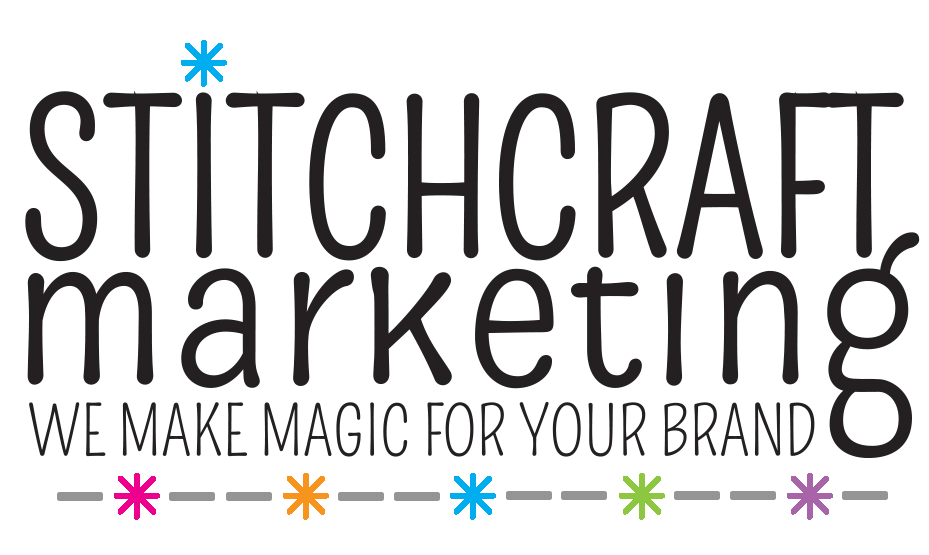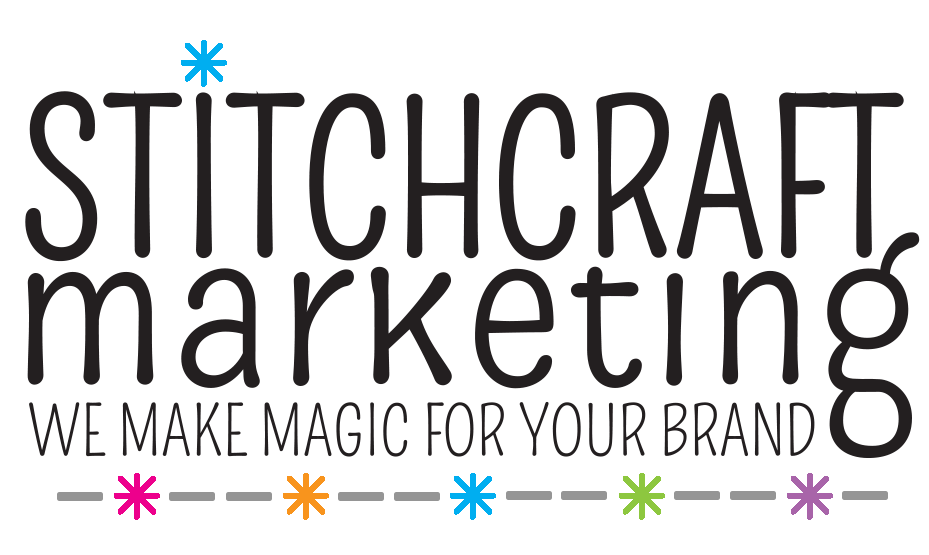14 Aug 7 Easy Advertising Strategies Smart Craft Businesses Will Love
Smart craft business owners know that creating beautiful products is only half the battle; getting those creations in front of the right people is just as important. However, with numerous advertising options available, it can be challenging to determine what truly works for small retailers or handmade brands. Traditional methods often feel too broad or expensive, while newer digital tactics can feel overwhelming or overly complicated.
At Stitchcraft Marketing, we’ve seen firsthand what works and what doesn’t when it comes to promoting artisan products. The good news? You don’t need a massive budget or a marketing degree to advertise effectively. Whether you’re selling on Etsy, your website, or at in-person markets or promoting events, there are practical, low-stress strategies that can help you attract more customers, grow your audience, and boost your sales.
At Stitchcraft Marketing, we employ tested advertising strategies tailored to craft businesses. These approaches communicate authentically and effectively and have proven successful with creative audiences. Our methods also won’t distract you from running your business and connecting with your audience.
1. Identify Your Target Customers
Start smart: Know who you’re talking to before you spend.
Before diving into ad platforms or budgets, be clear on who your ideal customers are. Are they yarn-loving retirees? Eco-conscious parents? Craft-curious beginners? Knowing your audience helps you craft ad messaging, choose the right visuals, and select the most effective advertising placements.
If you’re unsure where to start, check out this helpful Stitchcraft Marketing podcast episode on customer avatars. It walks through how to define your ideal craft audience in a way that’s both practical and personalized.
2. Set Up Your Campaign with the Right Goal
The right setup begins with a clear goal—and that goal drives everything else.
Before launching any ad, ask: What do I want this ad to do? The goal you choose—awareness, traffic, engagement, leads, sign-ups, or sales— will shape how the platform delivers your ad and what data it collects.
Why It Matters:
- Audience targeting: Meta and Google show your ad to people most likely to take the action you’ve chosen.
- Targeting vs. Retargeting:
- Targeting finds new people who match your ideal customer profile. Think interest-based or keyword-based audiences, like “knitting,” “handmade gifts,” or “DIY home decor,” as well as geographic factors, when relevant.
- Retargeting focuses on people who’ve already interacted with your brand, whether they have visited your website, clicked an email, added a product to cart, or engaged with your brand’s social channels. These audiences are warm and more ready to convert with the right nudge.
- Ad setup: The platform you choose will tailor placements and formats based on your goal. Not all platforms or ad types serve the same purpose.
- Data tracking: An ad’s configuration will dictate the data it tracks. For example, a sales campaign tracks purchases; a lead-gen campaign tracks signups or emails.
Pro tip: Even if you’re not running sales campaigns yet, setting up your Meta Pixel or Google Tag early ensures you’re collecting the data you’ll need later to run smarter, retargeted ads.
3. Meta Ad Strategies (Facebook & Instagram)
Meta ads are great for visual, community-driven craft brands, and you’ll get better results if you go beyond the Boost button.
Boosting a Post vs. Placing a Campaign
- Boosting is quick but limited, good for visibility or engagement, and puts Meta in the driver’s seat.
- Campaigns in Ads Manager offer better targeting, tracking, and conversions. You or your advertising partner can control an ad’s campaign configuration to match goals and establish targets, and conduct A/B tests quickly to put your budget in an effective and efficient ad set.
Tip: Use Boost for likes. Use campaigns to drive traffic or sales.
Use the Right Ad Formats
- Carousels – Highlight multiple products, while potentially acquiring multiple deliveries with each image within the ad.
- Videos – Show your process or product in action, while stopping the scroll more often than static ad types.
- Event Ads – Promote launches, markets, or live demos, with the bonus of event reminders sent directly to your audience when they mark “interested” or “going.” Event ads also allow your audience to invite their friends.
4. Google Ads: Be There When They’re Searching
Google Ads help you reach customers when they’re actively looking for what you sell.
Search Ads (AdWords): Appear at the top of search results for terms like “hand-dyed yarn” or “custom quilt.” Use specific keywords and location targeting to reach ready-to-buy shoppers.
Performance Max: An automated, all-in-one campaign that shows your ads across Google Search, YouTube, Gmail, Maps, and more. Use clear product images and strong copy; Google will test combinations to identify top performers. This ad type performs dynamically (testing combinations at the moment of bidding) using user data and is akin to programmatic advertising, which is up next.
Google Shopping: Your products appear as clickable images in search results. This works best when your website has structured product info (titles, prices, photos). Ideal for product-based craft businesses and retailers.
YouTube Pre-Roll: Short video ads that run before YouTube videos. Keep it under 15 seconds—even a quick 6 seconds of brand awareness performs well. Use visuals that grab attention fast (e.g., hands making something, colorful displays).
5. Programmatic + Geofencing: Smart Targeting
These advanced ad tools help you reach the right people, in the right place, at the right time, without a huge budget.
Programmatic Advertising: These are automated ads placed across websites, apps, and video platforms. You can use it for brand awareness or retargeting across the web. It’s efficient and scalable, even for small businesses with clear branding.
If you’ve ever searched for a pair of shoes on one website, then see an ad for that same shoe or shoe brand while on another website, you’ve witnessed programmatic advertising in action.
Geofencing Ads: This allows you to target people within a specific location, such as a craft fair, retail area, or zip code. This is perfect for local promotions, pop-up shops, or in-person workshops. Set a radius around the venue and run ads before, during, and after the event. You can also combine geofencing with retargeting. Show ads to people who visited your event area even days later.
You won’t be able to capture everyone. Geofencing requires certain location tracking settings approved on mobile devices, yet remains a strong tactic to collect and target people with highly specific interests.
6. Other Notables: Niche Platforms Worth Exploring
Not all ads need to run on Meta or Google. These platforms offer great value, especially for craft-focused brands.
Pinterest: Great for promoting visual products, your brand, on-demand classes, as well as your shoppable feed. Create ad pin tutorials, product bundles, and gift ideas. Use keyword-rich descriptions and test promoted pins to boost reach.
The main Pinterest ad types are Collections, Video, Carousel, Idea, Showcase, Quiz, and Premiere Spotlight, each serving a different objective or goal (Pinterest).
Ravelry: A low-cost option with a highly targeted audience of knitters and crocheters. Run simple banner ads for patterns, yarns, or kits. Stitchcraft has consistently seen even a small ad spend leading to strong returns.
Knitty: This trusted online magazine has been a go-to for fiber crafters for years. Consider this for launches, patterns, or yarn lines that align with their seasonal themes. View Knitty’s current rate card.
TikTok: Short-form video with huge viral potential. Use organic posts to test content, then promote what performs well. Show process videos, packaging behind-the-scenes, or product reveals.
7. Budgeting Tips for Craft Business Ads
Start small and stay in control.
You don’t need a big budget to get results. Many successful craft businesses start with just $5–$10/day on platforms like Meta or Pinterest. The key is to test, learn, and adjust as you go.
Quick Budgeting Tips:
- Start with one campaign at a time—focus on a single product, event, or lead magnet.
- Run tests for 5–7 days, then review results before scaling up.
- Use lifetime budgets (vs. daily) if your schedule is flexible, as this allows the platform to optimize spend.
- Factor in visuals or creative costs (photography, video, design), especially if outsourcing.
Pro tip: Always set a budget limit. You can increase it later, but a cap protects you while testing.
Bonus: Simple Ad Funnel Example for Craft Businesses
Ads work best when they’re part of a journey, not a one-time pitch.
Here’s a sample funnel to show how different ad types work together to attract, nurture, and convert:
Funnel Example: Digital Pattern + Product Sales
- Pinterest Ad – Promotes a free knitting pattern (email opt-in required)
- Email Welcome Series – Delivers the pattern, followed by tips and behind-the-scenes stories
- Instagram Retargeting Ad – Showcases a product bundle that complements the pattern
- Final Email CTA – Special discount or free shipping to encourage purchase
This approach warms up new audiences, builds trust, and gently guides them toward a sale without being pushy.
Start Small, Stay Consistent
Advertising doesn’t have to feel overwhelming or expensive. The key is to start with one or two strategies, track what’s working, and build from there. Whether you’re testing a Pinterest campaign, running a Meta carousel ad, or trying a local geofencing push, the smartest craft businesses treat advertising as part of the creative marketing process.
Not every ad will go viral, but every ad teaches you something about your audience.
Ready to Get Started?
Curious how to start advertising, or need a craft-minded advertising expert to take over your current campaign strategy? Contact Stitchcraft Marketing to get started.


No Comments